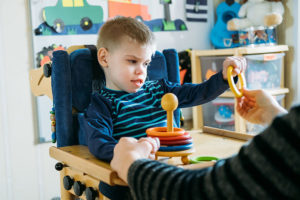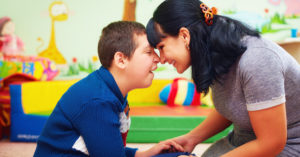What Is Cerebral Palsy?
Cerebral palsy is a group of neurological disorders that affect a person’s ability to move and maintain balance and posture.
CP affects different parts of the body, leading to varying symptoms and severity. The condition itself does not change with age. However, it can cause additional health issues and a lifetime of special care needs.
Cerebral palsy has no cure, but therapy and medication can improve your child’s quality of life. Depending on the severity of their condition, some patients may live independently, while others may need lifelong care.
Families impacted by cerebral palsy malpractice may be entitled to financial support. By filing a cerebral palsy lawsuit, you can pursue compensation to help pay for your child’s care. On average, birth injury lawsuits pay about $1 million.
The Birth Injury Justice Center partners with a network of experienced cerebral palsy lawyers who can help families nationwide. Together, they have recovered over $962 million for preventable birth injuries, including CP.
Find out if we can help your family – get a free legal case review right now.
Cerebral Palsy Causes
CP is usually caused by damage to the developing brain during pregnancy, birth, or shortly after birth. In many cases, the causes of cerebral palsy are unknown.
Damage can affect different parts of the brain, each controlling various motor movements.
 Motor cortex
Motor cortexDamage to the motor cortex causes spastic cerebral palsy, leading to increased muscle tone and very stiff muscles.
 Basal ganglia
Basal gangliaDamage to the basal ganglia causes dyskinetic cerebral palsy. Muscle tone can alternate from too loose to too tight, making it difficult to control the arms and legs.
 Cerebellum
CerebellumDamage to the cerebellum causes ataxic cerebral palsy, leading to difficulties with balance and coordination.
Damage to any part of the brain can result from various risk factors, with head injury or trauma being the most common.
Premature birth or low birth weight can also lead to brain damage and other complications.
Complications before or during delivery, like bleeding or lack of oxygen (hypoxia), can cause CP-related brain damage. Infections during pregnancy can also harm the fetus and lead to CP.
Proper medical care can help prevent these issues and reduce the risk of CP.
Cerebral Palsy and Medical Negligence
CP is sometimes a result of medical negligence, which occurs when medical staff do not provide proper care, putting your child in danger during childbirth.
- Delaying or not performing a needed cesarean section (C-section)
- Failing to monitor the baby’s heartbeat and vital signs
- Forcing, pulling, or twisting a baby out of the birth canal during delivery
- Failing to treat fetal distress, like lack of oxygen (hypoxia)
- Ignoring or improperly treating maternal infections or fetal infections like meningitis
- Mismanaging umbilical cord prolapse (when the cord drops down before the baby)
- Misusing assisted delivery tools, like forceps or vacuum extractors
If your delivery team didn’t provide proper treatment and support, they might be responsible for your child’s CP.
This means you could be eligible to file a lawsuit with the help of a cerebral palsy lawyer.
Find out right now with a free case review.
5 Types of Cerebral Palsy
There are five main cerebral palsy types, with each type affecting different areas of the brain and presenting different symptoms. Learn more about the types of CP below.
1. Spastic Cerebral Palsy
This is the most common form, making up almost 80% of cases. Spastic cerebral palsy is caused by trauma or injury to the motor cortex portion of the brain.
Those who suffer from spastic CP experience chronically tense muscles or hypertonia. Hypertonia may impact different parts of the body as well, resulting in loss of control over the affected limbs.
There are 3 subtypes of spastic cerebral palsy.
Spastic Hemiplegia
This subtype of CP affects only one side of the body. Common signs include a constantly clenched fist or limbs consistently tucked to one side.
Spastic Diplegia
This affects only the lower half of the body. Infants and toddlers may struggle to learn to walk, often using their toes instead of the whole foot. It is also known as “Little’s Disease.”
Spastic Quadriplegia
This is the most severe form of spastic CP, affecting all four limbs and the entire body. Symptoms appear early in life, with children often missing milestones like head control and crawling within the first year.
2. Ataxic Cerebral Palsy
This is a rare type of CP, accounting for about 5-10% of cases.
Ataxic cerebral palsy occurs when the cerebellum is permanently damaged. The cerebellum does not control physical movement but sends signals to the body for muscles to move smoothly, regulating posture and balance.
These signals may occur too slowly or not at all, resulting in unsteady movement, reduced muscle tone, and lack of coordination (ataxia).
Ataxia typically affects all or most of the body at once but may impact any part of the body, including the arms, legs, fingers, eyes, and throat.
A mix of early intervention, therapy, and medication can help people with ataxic CP thrive in their daily lives.
3. Athetoid/Dyskinetic Cerebral Palsy
Athetoid CP, also known as dyskinetic cerebral palsy, is found in 20% of patients.
This type of CP is caused by injury to the basal ganglia, an area of the brain responsible for automatic movement, fine voluntary movements, and posture.
The specific type of athetoid CP experienced depends on which part of the basal ganglia is damaged.
- Choreoathetoid dyskinetic: Characterized by two types of movements – athetosis (slow, writhing) and chorea (rapid, jerky), patients experience fluctuating muscle tone, affecting posture and movements.
- Dystonic dyskinetic: This subtype causes muscle contractions when a patient tries to move, leading to awkward postures, repetitive movements, and slow twisting.
Early diagnosis and intervention can help manage symptoms effectively.
4. Hypotonic Cerebral Palsy
Hypotonic CP, caused by cerebellum damage, is one of the rarest types, affecting only 2.6% of patients.
It results in low muscle tone, leading to floppy muscles and poor stability. Children with hypotonic CP often miss developmental milestones like rolling over or walking and are at a higher risk for falls once walking begins. They may also have difficulty with eating and speaking.
Early diagnosis and treatment, like physical, occupational, and speech therapies, can help manage symptoms and improve quality of life.
5. Mixed Type Cerebral Palsy
Cerebral palsy is an umbrella term for conditions that impair brain and nervous system functions. Mixed cerebral palsy combines different types.
Mixed CP can impair your child’s movement, cognition, sight, and hearing.
Cerebral Palsy Symptoms
Symptoms of CP may affect muscle control, coordination, balance, and cognitive development. The type and severity of a patient’s condition influence their symptoms. In most cases, symptoms take months or years to become apparent.
Learn more about the symptoms of CP below.
Physical Symptoms
Cerebral palsy often affects muscle control and physical abilities, leading to various challenges.
- Difficulty sucking, eating, or swallowing
- Excessive drooling
- Favoring one side of the body
- Floppy muscle tone
- Jerky, involuntary movements or tremors
- Lack of coordination and fine motor skills
- Mobility problems or toe-walking
- Stiff or variations in muscle tone
If you notice any of these symptoms, discuss them with your child’s pediatrician to ensure they get the treatment they need.
Neurological Symptoms
Cerebral palsy can also impact neurological functions, resulting in a range of symptoms.
- Abnormal pain or touch perception
- Delays in developmental skills
- Learning disabilities
- Seizures
A neurologist can provide guidance on managing these symptoms.
Speech-Related Symptoms
Cerebral palsy often affects muscle control and physical abilities, leading to various challenges.
- Abnormal speech rhythms
- Hoarse voice
- Monotone voice
- Nasally voice
Speech therapy can help address these issues effectively.
Your Next Steps if Symptoms Appear
It’s important to understand that CP is usually not diagnosed until children begin to miss developmental milestones. This is because symptoms may go unnoticed or even resemble those of other conditions.
If your child is showing symptoms of CP and things didn’t seem right during childbirth, you probably have unanswered questions.
The Birth Injury Justice Center has experienced labor and delivery nurses who are standing by to help.
Connect with one of our registered nurses right now in confidence.
Cerebral Palsy Diagnosis
To make a cerebral palsy diagnosis, your child’s doctor will review their medical history and perform assessment tests. These tests will help them determine the specific type of CP your child has — or if they have a different diagnosis altogether.
Most children who have cerebral palsy are diagnosed within the first 3 years of life.
Your child’s doctor may also order more advanced tests, like an ultrasound, MRI, or EEG, to confirm the diagnosis. These tests allow doctors to study the brain to pinpoint the location and extent of the damage, helping them make a more accurate diagnosis.
To perform a complete assessment, the doctor may conduct hearing, vision, speech, and intellectual tests to take note of any developmental delays and observe your child’s muscles and motor skills.
If your child was diagnosed with CP and you suspect something went wrong to cause their condition, we may be able to help.
Call us right now at (800) 914-1562 or Click to Live Chat to talk with a member of our team.
Cerebral Palsy Life Expectancy
When a child is diagnosed with CP, they will also receive a prognosis, which is a doctor’s estimate of the short- and long-term outcomes of your child’s diagnosis.
The main factors determining cerebral palsy life expectancy are the severity of impairments, mobility limitations, and feeding and swallowing difficulties.
Children with mild CP who can move fully and self-feed generally have a normal life expectancy. In contrast, children with severe CP who need extensive care may have a shorter life expectancy.
For example:
- Can feed self
- Minimal motor skill impairment
- Chance of living to 20 years old: 99%
- Needs a feeding tube
- Uses a wheelchair
- Chance of living to 20 years old: 40%
People with CP who receive proper medical care, use adaptive equipment, and maintain mobility tend to have a longer life expectancy and greater independence.
Does CP Get Worse With Age?
Unlike many other serious health conditions, CP does not worsen over time since the brain injury occurred in one isolated instance.
However, other factors and separate conditions not caused by the initial brain injury may impact health and life expectancy over time.
As children with CP grow, they may face new challenges, like muscle stiffness (including permanent tightening with contractures), joint problems, or movement difficulties due to natural aging and muscle wear.
Regular medical care and therapy can help manage these symptoms and maintain mobility and function. Early intervention and consistent treatment are crucial to improving the quality of life for those with CP.
Cerebral Palsy Treatment


While there is no cure for CP, various treatments can help manage the condition. Cerebral palsy treatments, like medication, surgery, and therapy, aim to reverse effects and help children overcome symptoms.
Treatment plans vary based on severity. For example, children with severe epilepsy may need medication to prevent seizures, while those with milder CP might only require ongoing physical therapy. Surgery is typically a last resort.
All treatments aim to improve the quality of life and help children live more independently. Learn more below.
Therapy
Cerebral palsy therapy is one of the best options to treat and manage your child’s condition.
- Physical therapy: Uses specific exercises to help improve flexibility, balance, movement, motor skills, and muscle strength.
- Speech therapy: Helps children who have difficulty with the movement of their mouth, which can affect their speech and communication skills.
- Occupational therapy: Focuses on helping children become more independent in school, work, and home environments.
- Aquatic therapy: Helps children move muscles more freely while immersed in water. Trained therapists hold therapy sessions in pools with water-focused adaptive exercise equipment.
Children may benefit from multiple types of therapy to decrease cerebral palsy symptoms.
Medication
There are several different types of cerebral palsy medications that can help treat symptoms like seizures and spasticity (tight muscles).
Individuals with CP may also need medications for:
- Constipation
- Mood disorders
- Pain management
- Sleep difficulties
- Urinary dysfunction
Since each child is different, the use of medications can vary depending on their main symptoms.
Surgery
Cerebral palsy surgery may be necessary if symptoms do not respond well to other forms of treatment or cause complications that cannot be eased by therapy. Certain surgeries help to reduce symptoms like muscle spasticity or contractures.
Advances in Cerebral Palsy Treatment
Research and treatment for cerebral palsy are continually evolving. Cutting-edge treatments can greatly improve quality of life.
- Brain research: Studies on brain development and injury, including brain damage prevention and white matter development, provide new insights into CP treatment and prevention.
- Cooling therapy: Systemic hypothermia, which involves cooling the body’s core temperature, is being studied to treat brain injuries and potentially prevent CP.
- Genetic research: Scientists are studying genetic factors to create personalized treatments and diagnose CP earlier through DNA analysis.
- Neuroimaging and biomarkers: Advanced imaging techniques help predict CP in preterm infants and tailor treatments through brain mapping.
- Stem cell therapy: Clinical trials are testing stem cell infusions to repair damaged brain tissues in children with CP.
These advancements offer hope for new treatments and a better quality of life for those with CP. Given the high costs of these cutting-edge treatments, financial compensation from a cerebral palsy settlement can help ensure your child receives the best possible care.
Get a free case review right now to see if you could be eligible.
Living With Cerebral Palsy
Living with cerebral palsy can be challenging, but it’s important to remember that you are not alone. With determination and the right support, individuals with CP can lead fulfilling lives.
Advances in treatment have made it possible to manage symptoms and significantly improve quality of life. From physical therapy to innovative medical procedures, these treatments offer hope and a better future.
These therapies can be beneficial for people living with CP:
- Constraint-induced therapy (CIT): The unaffected limb is restrained to encourage the use of the affected limb.
- Functional electrical stimulation (FES): Electrical impulses stimulate nerves and muscles to contract.
- Robotic therapy: Robots assist with movement training and rehabilitation.
Emerging treatments, like Botox injections and vibration therapy, are being researched to manage CP symptoms and enhance quality of life.
Creating a CP treatment plan personalized for your child’s unique needs can help improve mobility, strength, and daily functioning.
However, these treatments can also be costly. Financial support, such as compensation from cerebral palsy lawsuit settlements, can make a huge difference, ensuring access to the best care and helping to achieve greater independence and well-being.


Cerebral Palsy Financial Assistance and Resources
CP treatment costs can take a financial toll on your family — and if your child’s birth injury was preventable, you should not be solely responsible for medical bills. Fortunately, there are many resources your family can take advantage of to get the financial assistance you deserve.
Cerebral palsy financial support organizations can ease financial stressors. They offer grants and assistance to help pay for therapy, medications, surgeries, and education.
Additionally, filing a cerebral palsy lawsuit may allow families to access the financial compensation needed to provide a better future for their children.
Cerebral palsy attorneys can analyze the facts of your case and try to secure the highest amount of compensation possible.
If your child developed CP stemming from medical malpractice or negligence, you can help protect your child’s future by pursuing justice on their behalf.
Get Legal Help for Cerebral Palsy Medical Malpractice
Raising a child with CP can feel overwhelming, especially when faced with high medical costs. Fortunately, there are resources available to help families cover treatment and other expenses.
Financial assistance for cerebral palsy can ease the burden on your family, allowing you to focus on your child’s care. If you believe your child’s CP could have been prevented, filing a CP lawsuit may be a path to the financial support you need.
But don’t wait. A law called the cerebral palsy lawsuit statute of limitations places a strict deadline on the time you have to file your claim.
The Birth Injury Justice Center partners with top lawyers nationwide, helping families in all 50 states. Together, they have recovered over $962 million for those affected by preventable birth injuries, including CP.
Call us right now at (800) 914-1562 or get a free case review to find out how we can help you secure a better future for your child.
Cerebral Palsy FAQs
When is cerebral palsy diagnosed?
CP is typically diagnosed within a child’s first 3 years, but it can take longer if the symptoms are mild.
Although CP is almost always present at birth, it often goes undetected until years after childbirth, making it difficult to diagnose early on in life.
This can make it difficult for a doctor to pinpoint the exact cause of the damage that led to your child’s condition.
What does mild cerebral palsy look like?
Mild cerebral palsy typically involves slight problems with balance or coordination. However, the signs of mild cerebral palsy often go undetected for years.
Based on the Gross Motor Function Classification System (GMFCS), children with mild CP fall in the Level I classification and are fully independent and able to perform most physical activities with only slight problems in balance or coordination.
How common is cerebral palsy?
The Centers for Disease Control and Prevention (CDC) states that CP is the most common childhood motor disability, affecting approximately 1 in 345 children in the United States.
Each year, about 10,000 babies born in the United States will develop cerebral palsy, according to the CDC.
How does cerebral palsy affect the brain?
Cerebral palsy is caused by permanent damage to the brain, which can affect the brain’s control over muscles and the nervous system.
Muscles are unable to respond to the brain’s signals for movement, causing spastic or floppy muscles and overall lack of motor function.
CP can also affect cognitive development and overall brain functioning.
Can a person with cerebral palsy live a normal life?
Yes, many people with cerebral palsy can live a fulfilling life. With the right treatments, therapies, and support, individuals with CP can manage their symptoms, achieve greater independence, and participate in everyday activities.
While challenges exist, advancements in medical care and adaptive technologies continue to improve the quality of life for those with CP.
What is cerebral palsy caused by?
Cerebral palsy is caused by brain damage that occurs before, during, or shortly after birth. This damage can result from infections during pregnancy, lack of oxygen during delivery, or head injuries in early infancy.
In some cases, medical mistakes during childbirth can lead to CP. If you suspect medical errors contributed to your child’s condition, get a free case review to learn about your legal options.
What is the life expectancy of a child with cerebral palsy?
The life expectancy of a child with cerebral palsy varies but can be near average with proper medical care and support. Many factors, like the severity of the condition and associated health issues, influence life expectancy.
Can you sue for cerebral palsy?
Yes, you may be able to sue for cerebral palsy if it was caused by medical negligence. If you believe your child’s condition resulted from a medical mistake, you may have legal options.
Call us right now at (800) 914-1562 to find out if we can connect you with an experienced CP lawyer near you.








